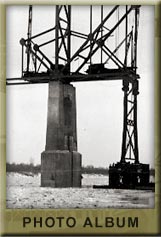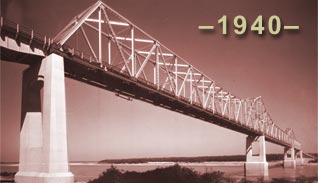 |
|
| |

|
| |

| Construction photos of the
original bridge, taken by Massman Construction
of Kansas City, MO, contractor for both the
1940 and New Greenville bridges. Click to
view. |
|

The original Greenville Bridge was
a giant of its time, a steel through-truss design with
a main span of 840 feet (256 meters) — the longest
span for a highway bridge anywhere on the Mississippi
River until 1943, when an 845-foot bridge at Dubuque,
Iowa, was completed.
The 1940 Bridge was designed by
Ash Howard Needles and Tammen of Kansas City, Missouri,
a firm that had a number of major projects in its portfolio
at the time, including Mississippi River bridges in
Vicksburg (1930), Natchez (1937), and Cape Girardeau,
Missouri (1926).
In sixty-plus years, the Greenville
Bridge has weathered the wrath of the Mississippi River
and ever-increasing volumes of highway and river traffic.
Since 1972, it has sustained more barge collisions than
any other bridge on the Mississippi; in the 1950s, an
airplane from  the
nearby Greenville Air Force Base crashed into the bridge.
Though the 1940 Greenville Bridge remains structurally
as sound as ever, the bridge is considered functionally
obsolete by modern standards: the
nearby Greenville Air Force Base crashed into the bridge.
Though the 1940 Greenville Bridge remains structurally
as sound as ever, the bridge is considered functionally
obsolete by modern standards:
- Total roadway width is 24 feet
with no shoulders.
- An overall sufficiency rating
of 47.5 from the Federal Highway Administration (FHA)
makes the bridge eligible for replacement funding.
- The sharp vertical crest of the
bridge reduces sight distance far below current criteria
required by the Mississippi Department of Transportation.
- The location of the bridge makes
it highly prone to marine vessel collisions.
In 1994, the Mississippi Department
of Transportation (MDOT) issued an engineering study
report that explored a four-lane crossing for US 82
at Greenville. The study identified three construction
alternatives that would accomplish the goal: two alternatives
called for building new bridges and removing the old
bridge; a third alternative explored keeping the old
bridge and building a new bridge immediately next to
it — a strategy similar to that used in Natchez. It
was concluded that a new bridge should be located approximately
half a mile down river from the old bridge, and that
the old bridge should be removed.
Further studies considered bridge
types: should the new bridge be a steel through-truss
similar to the existing structure, or would another
type of bridge be more suitable? In 1995, the cable-stayed
design was identified as the preferred bridge type.
Other factors would influence the design of the new
bridge: the width of the river, subsurface soil conditions,
required river navigation clearances and river channel
maintenance issues.
By the end of 1999, the studies were over and the engineers
had drawn their plans. The result: the New
Greenville Bridge.
|